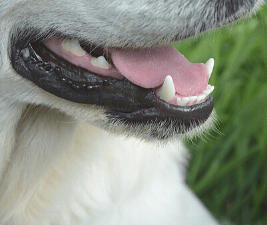Taking care of your dog’s teeth isn’t fun. It’s not convenient. And you could, possibly, get nipped. It’s also one of the most important things you can do for your dog’s health.
A friend of ours found this out the hard way. Last week her dog had periodontal surgery. He lost about 10 teeth, and is on massive antibiotics to stop the bone loss due to bacterial disease. Left untreated, the gum disease could have led to massive systemic infection, and damage to his heart. Her dog is four years old.
Caring for dog teeth
Fortunately, caring for your dog’s teeth is easy. Veterinarians recommend brushing twice a day, but for many/most of us, that’s just not going to happen. We make sure to brush our dog’s teeth once a week – it happens more often if we notice something going on. Human toothpaste isn’t recommended – get a good one designed for dogs, like our own GG Naturals Dog Toothpaste. Just dab some on a piece of gauze or washcloth and rub your dog’s teeth. Done on a regular basis, your dog may not love it, but he/she will get used to it.
We’re lucky that our dogs all seem to have a mouth chemistry that doesn’t contribute to dental disease. Our friend wasn’t lucky at all. She didn’t expect any problems since none of her other dogs have had the issue. And dogs are notorious for not showing signs of disease until it’s advanced too far to reverse.
Signs of trouble
According to Web MD, the signs of periodontal disease in dogs include:
- Problems picking up food
- Bleeding or red gums
- Loose teeth
- Blood in the water bowl or on chew toys
- Bad breath (halitosis)
- “Talking” or making noises when a dog eats or yawns
- Bumps or lumps in the mouth
- Bloody or ropey saliva
- Not wanting the head touched (head shyness)
- Chewing on one side of the mouth
- Sneezing or nasal discharge (advanced gum disease in the upper teeth can destroy the bone between the nasal and oral cavity)
We don’t even want to think about what the dental surgery cost our friend. Not to mention the worry and recovery time. Her dog’s entire future is changed – his favorite hard chew toys are now off-limits. She only noticed an issue when one of her dog’s teeth seemed loose. The disease had already progressed too far to save the teeth.
Benefits of caring for dog’s teeth
To be completely honest, we’re not so much obsessed with our dogs having pretty teeth as we are terrified of any of them undergoing anesthesia. We’ve only heard of one veterinarian in our area who does dog teeth-cleaning without putting the dog under anesthesia. And, while we trust our veterinarian, we do have flat-faced dogs who have more difficulty with anesthesia. Since there’s a simple thing we can do to put it off as long as possible, or avoid it entirely, we’re going to do it. Tango is our oldest dog at 11. So far, so good. Like many Toy breed dogs (he’s a Brussels Griffon), Tango never had a full complement of teeth. But he still has all of them, and has never had to have a professional cleaning.
Start where you are
Even just rubbing your dog’s teeth and gums with a washcloth will help. While you’re waiting for your Dog Toothpaste to arrive – start. Small steps can make a big difference and it may save worry, money, and your dog’s teeth.









